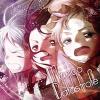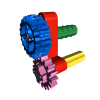Search the Community
Showing results for tags '3-axle'.
Found 2 results
-
Greetings, Train Tech! About a year ago, I posted my Umbauwagen 4yg. Here is the 3-axle variant, the 3yg: The name Umbauwagen means "rebuilt coach" -- these coaches were built after World War 2 by modernizing prewar compartment coaches. More accurately, this is an AB3yg (first/second class) + B3yg (second class) pair -- these cars were nearly always found in close-coupled pairs. A few survive as single units in work trains, painted yellow. The body of the model is essentially constructed the same way as my 4yg model: studs-up construction for the main body (leveraging the train window and the 2x8x2 curved slope), SNOT construction for the doors, the details around the buffer, steps, and corridor bellows. Of course I designed new side frames, and there are a few minor details that are different such as the lights above the end doors of the pair. These cars were painted green in DB service, but as the train window does not come in green I elected to build the 3yg in a different color scheme. I believe that this livery corresponds to 3yg cars used as trailers for the ET 85 electric units -- someone with more knowledge of German railways may be able to shed more light on this. At the time I built the 4yg I also built some test models to research how feasible it would be to build the three-axle variant. However, I ran into difficulties designing the chassis and moved on building the 4-axle variant instead (which had none of these challenges). Earlier this year I circled back and spent some time looking into the problem. The first attempt was to articulate the chassis as 4+2, pivoting the body to reduce the overhang -- a technique I previously used on the tender for my model of the Gr670. However, the Umbauwagen 3yg not only has a long 3-axle wheelbase, but also has a long distance between the outer axles and the buffers: Articulating the chassis as 4+2 would allow the car to negotiate turns, however it would also derail any vehicle attached to it as the buffers swung out widely. Further iteration yielded the general outline of my eventual solution: The center and end axles are connected together with a 6-bar linkage, rather than a rigid frame, allowing the chassis to change shape when traveling through curves. It's important to note that the center axle is actually what actuates the system. As the car enters a curve, the center axle is pushed sideways to follow the curve, which in turn angles the outer axles to follow the curve as well. The track cannot apply rotational forces through a single pair of wheels on one axle, and so a similar design to this one without the center axle would not work. You can see the mechanism here: The outer axles are mounted on 2x2 round bricks riding in a 2-stud-wide channel, allowing them to turn and slide slightly towards the center of the car in turns. I experimented a bit to find the best places for the pivots and a construction that would be light and reliable. In the final model I removed the blue tiles shown in the screenshot, to avoid additional friction and binding in the mechanism. Thanks for following along! As usual, I've uploaded some additional images to a Brickshelf gallery, including some notes on and prototypes of the linkage mechanism. Thanks for reading, and let me know if you have any questions!
- 13 replies
-
- passenger car
- umbauwagen
- (and 7 more)
-
I'm not really a regular truck builder, but I like to think of new systems that do not exist in real life yet but that do improve the life of, for example, truck drivers. When something like a big tarmac machine has to drive onto a trailer to go to the next building site, the slope of the trailer should be very small. That small slope is nowadays achieved by making very large ramps that fold up vertically for transport, causing massive air resistance and therefore unnecessary fuel consumption. A way to make these ramps shorter is to decrease the bed height, because that asks for smaller vertical ramps. The second option is making the wheels below the bed smaller. But decreasing the wheel diameter increases the rolling resistance. Another way to solve the problem is placing the bed betweeen the wheels, so that it can be much lower, but that limits the cargo width: the tarmac machine can never be wider than the bed width, which is not handy if truckdriver x has to transport many different tarmac machines. Read the rest of the story and how I solved these problems with my my DAF CF with 3-axle trailer on http://mocpages.com/moc.php/421622 Or watch the video here: To give an idea of the model, I have posted one photo below, the others can be found on http://www.brickshel...ry.cgi?f=560197 in a better resolution.[/font][/size]


